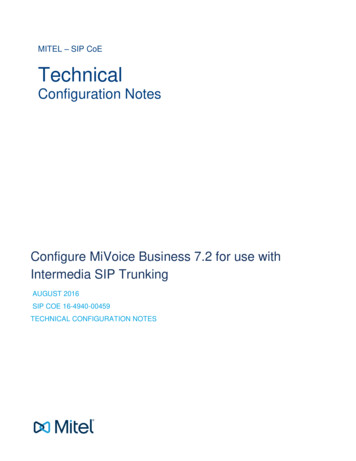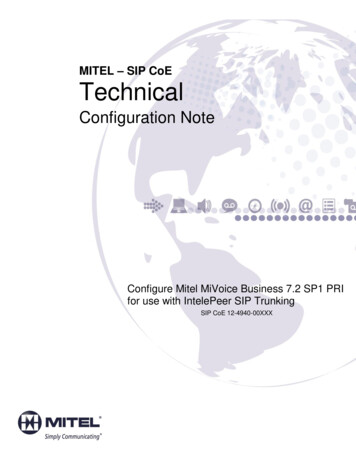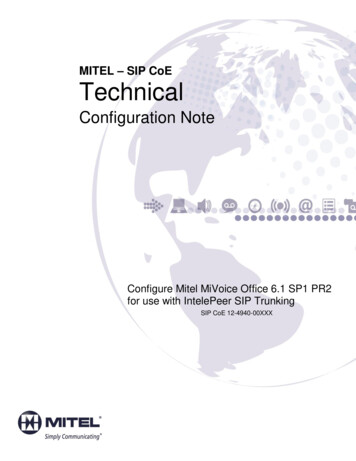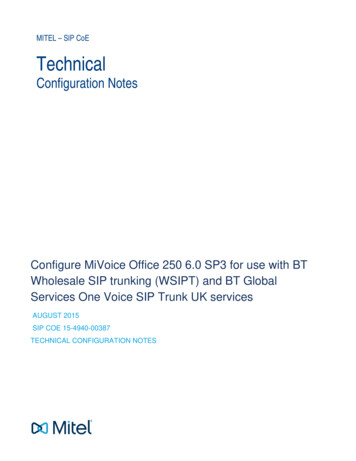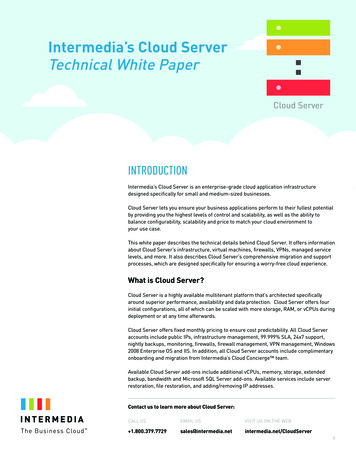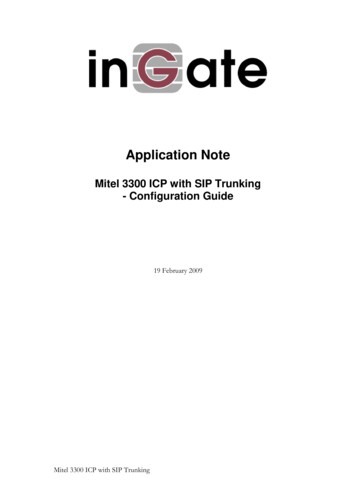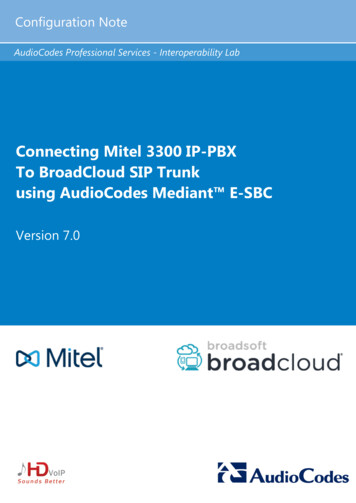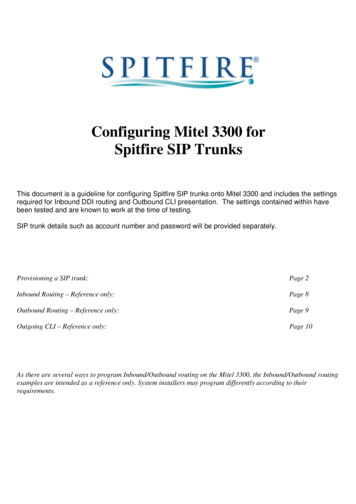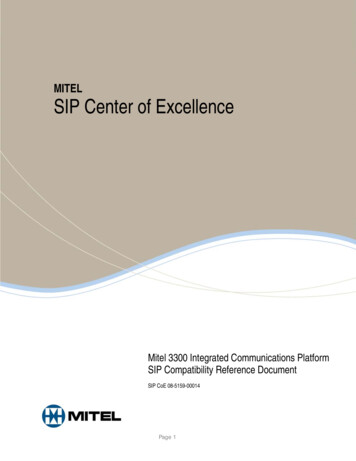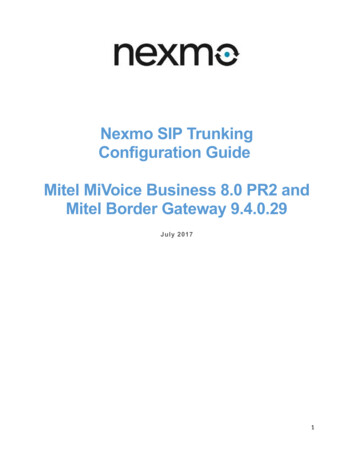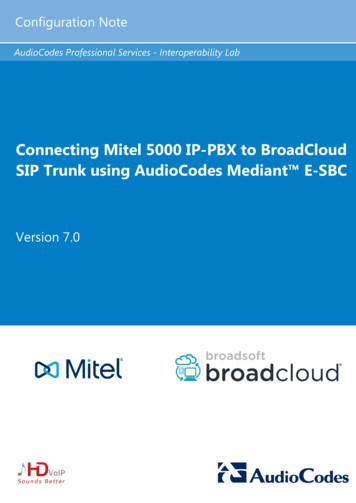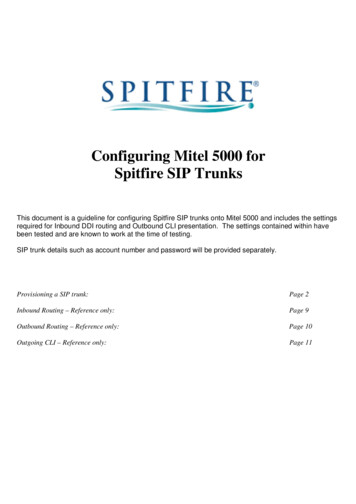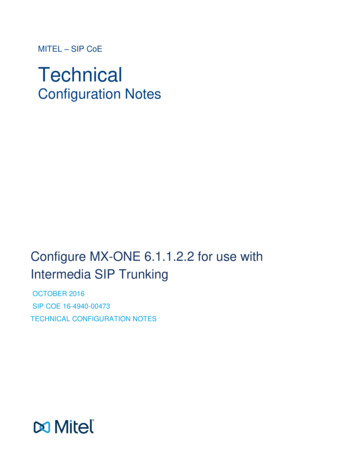
Transcription
MITEL – SIP CoETechnicalConfiguration NotesConfigure MX-ONE 6.1.1.2.2 for use withIntermedia SIP TrunkingOCTOBER 2016SIP COE 16-4940-00473TECHNICAL CONFIGURATION NOTES
NOTICEThe information contained in this document is believed to be accurate in all respects butis not warranted by Mitel Networks Corporation (MITEL ). The information is subjectto change without notice and should not be construed in any way as a commitment byMitel or any of its affiliates or subsidiaries. Mitel and its affiliates and subsidiariesassume no responsibility for any errors or omissions in this document. Revisions of thisdocument or new editions of it may be issued to incorporate such changes.No part of this document can be reproduced or transmitted in any form or by any means electronic or mechanical - for any purpose without written permission from Mitel NetworksCorporation.TRADEMARKSMitel is a trademark of Mitel Networks Corporation.Windows and Microsoft are trademarks of Microsoft Corporation.Other product names mentioned in this document may be trademarks of their respectivecompanies and are hereby acknowledged.Mitel Technical Configuration Notes:Configure MX-ONE 6.1.1.2.2 for use with Intermedia SIP TrunkingOctober 2016 – 16-4940-00473 , Trademark of Mitel Networks Corporation Copyright 2016, Mitel Networks CorporationAll rights reservedii
Table of ContentsOVERVIEW . 1Interop History. 1Interop Status . 1Software & Hardware Setup . 1Tested Features . 2Device Limitations and Known Issues . 3Network Topology . 4CONFIGURATION NOTES . 5MiVoice MX-ONE Configuration Notes . 5Network Requirements . 5Assumptions for MiVoice MX-ONE Programming . 5Licensing – SIP Trunk Licensing . 6Route – Adding the SIP Route . 7Number Series . 14Destination . 16MiVoice Border Gateway Configuration Notes . 19MBG SIP Options . 19Adding MiVoice MX-ONE to MBG . 20SIP Trunk Configuration . 21APPENDIX A . 22System software Release. 22Route Provisioning . 22APPENDIX B . 24Route Setup . 24References . 26iii
16-4940-00473Intermedia SIP Trunking with MX-ONEOverviewThis document provides a reference to Mitel Authorized Solutions providers for configuringthe MiVoice MX-ONE 6.1 SP1 HF2 to connect to the Intermedia SIP trunk. Differentcomponents can be configured in various configurations depending on your VoIP solution.This document covers a basic setup with required option setup.Interop HistoryVersion1DateSeptember, 2016ReasonInitial Interop with MiVoice MX-ONE 6.1 SP1 HF2 and IntermediaSIP Service Provider v16.14.3Interop StatusThis Interop of Intermedia with MiVoice MX-ONE 6.1 SP1 HF2 has been given a CompatibleCertification status. This SIP trunk will be included in the SIP CoE Reference Guide.The most common certification which means MiVoice MX-ONE hasbeen tested and/or validated by the Mitel SIP CoE team. Productsupport will provide all necessary support related to the interop, butissues unique or specific to the 3rd party will be referred to the 3rd partyas appropriate.Software & Hardware SetupThe table below provides the hardware and software specifications used to generate basiccalls, using Intermedia SIP trunk connected to MiVoice MX-ONE 6.1 SP1 HF2.ManufacturerVariantIntermediaSession Border ControllerMitelMiVoice MX-ONESoftware Version16.14.36.1 SP1 HF2 (MP: 6.1.1.2.2.456.3,SNM: 6.1.1.2.9.458.3)MitelMiCollab – Audio, Web and VideoConferencingMitelMX-ONE Lite (aka A700) - MGUMitelMBG SIP TrunkMitel68xxi SIP setMSL: 10.3.34, MiCollab 7.9.9.98MSL: 10.5.9.0, MBG: 9.3.1.54.1.0.128 or 4.2.0.1811
16-4940-00473Intermedia SIP Trunking with MX-ONETested FeaturesBelow table provides an overview of the features tested during the Interoperability test cycleand not a detailed view of the test cases. Please see the SIP Trunk Side Interoperability TestPlan for detailed test cases.FeatureIssuesBasic CallMaking and receiving a call through SIP service providerand their PSTN gateway, call holding, transferring,conferencing, busy calls, long calls durations, variablecodec.Automatic CallDistributionMaking calls to an ACD environment with RAD treatments,Interflow and Overflow call scenarios and DTMF detection.NuPoint VoicemailTerminating calls to a NuPoint voicemail boxes and DTMFdetection.PacketizationForcing the Mitel MIVB to stream RTP packets through itsE2T card at different intervals, from 10ms to 60ms.Personal RingGroups (PRG)Receiving calls through MiVoice MX-ONE and their PSTNgateway to a personal ring group. Also moving callsto/from the prime member and group members.TeleworkerMaking and receiving a call through MiVoice MX-ONE andtheir PSTN gateway to and from Teleworker extensions.VideoMaking and receiving a call through MiVoice MX-ONE withvideo capable devices.FaxG.711 Fax calls.- No issues found2Feature Description- Issues found, cannot recommend to use- Issues foundNot tested/applicable
16-4940-00473Intermedia SIP Trunking with MX-ONEDevice Limitations and Known IssuesThis is a list of problems or not supported features when Intermedia SIP trunk is connected tothe. MiVoice MX-ONE 6.1 SP1 HF2FeatureFAXProblem DescriptionIntermedia does not support FAX using T.38.Recommendation: Consult with Intermedia for further information andupdates.PRACKIntermedia does not support PRACK correctly in the following callscenario,- A call from Mitel to PSTN service such as conferencing or IVR system- The PSTN sends alerting 183 and immediately connecting the call with200 OKRecommendation: Mitel recommends to disable PRACK when SIPTrunking with Intermedia. Consult with Intermedia for further informationand updates should PRACK be needed.VideoIntermedia does not support Video.Recommendation: Consult with Intermedia for further information andupdates.3
16-4940-00473Intermedia SIP Trunking with MX-ONENetwork TopologyThis diagram shows how the testing network is configured for reference.Mitel SIP InteroperabilityNetwork ConfigurationMitel 6867iSIP PhoneMitel 6865iSIP PhoneMiVoice MX-ONE(Virtualized)MX-ONE Lite - MGUMitel 6863iSIP PhoneFigure 1 – Network Topology4Intermedia SBC
16-4940-00473Intermedia SIP Trunking with MX-ONEConfiguration NotesThis section is a description of how the SIP Interop network was configured. These notesprovide a guideline as how a device can be configured in a customer environment and howthe Intermedia and MiVoice MX-ONE programming were configured in our test environment.Disclaimer: Although Mitel has attempted to setup the interop testing facility as closelyas possible to a customer premise environment, implementation setup could bedifferent onsite. YOU MUST EXERCISE YOUR OWN DUE DILIGENCE IN REVIEWING,planning, implementing, and testing a customer configuration.MiVoice MX-ONE Configuration NotesThe following information shows how to configure a MX-ONE 6.1 SP1 HF2 to interconnectwith Intermedia.Network Requirements There must be adequate bandwidth to support the VoIP network. As a guide, theEthernet bandwidth is approx 85 Kb/s per G.711 voice session and 29 Kb/s per G.729voice session (assumes 20 ms packetization). As an example, for 20 simultaneous SIPsessions, the Ethernet bandwidth consumption will be approx 1.7 Mb/s for G.711 and0.6Mb/s. Almost all Enterprise LAN networks can support this level of traffic without anyspecial engineering. Please refer to the MiVoice MX-ONE Engineering guidelines on theMitle eDocs Website (http://edocs.mitel.com) for further information. For high quality voice, the network connectivity must support a voice-quality grade ofservice (packet loss 1%, jitter 30ms, one-way delay 80ms).Assumptions for MiVoice MX-ONE Programming The SIP signaling connection uses UDP on Port 60605
16-4940-00473Intermedia SIP Trunking with MX-ONELicensing – SIP Trunk LicensingEnsure that the MiVoice MX-ONE is equipped with enough SIP trunking licenses for theconnection to the Intermedia. This can be verified using license status CLI command.The MiVoice MX-ONE Service Node Manager (SNM) web interface provides CLI capabilitiesusing Tools Command Line. Please note that only an administrator user with SystemSetup Admin security profile has access to Tools menu.Figure 2 – SIP Trunk Licensing6
16-4940-00473Intermedia SIP Trunking with MX-ONERoute – Adding the SIP RouteThe Route form is used to create and configure MiVoice MX-ONE SIP trunks.In SNM web interface, navigate to Telephony External Lines Route and click on Addbutton.Figure 3 – View SIP RoutesSelect SIP as the Type of Signaling, and Default as the Profile Name and click Next.Figure 4 – Add SIP RouteNote that it is recommended to create your own profile using Default profile as template. Allprofiles are in following directory on MiVoice MX-ONE: /etc/opt/eri sn/sip trunk profiles.Please note that after creating a new profile should issue start --system command so thatthe newly created profile appears in the drop-down list.7
16-4940-00473Intermedia SIP Trunking with MX-ONEProvide Route name and select an available Route Number from the drop-down list, and clickNext.Figure 5 – Add SIP Route – General8
16-4940-00473Intermedia SIP Trunking with MX-ONEOn SIP page of Adding SIP Route, provide below SIP related information Trusted Privacy Domain: User Proxy Address: Internal IP address of MBG Proxy Port Number: 5060 Unknown Public Number: sip:?@ Provider’s IP Address (ex, sip:?@64.28.122.44) Type of Accepted Calls: Remote IP Address of Numbers to Match Incoming Call: Internal IP address of the MBGFigure 6 – Add SIP Route – SIPClick the Next button.9
16-4940-00473Intermedia SIP Trunking with MX-ONESelect Server and add a Trunk Index.Figure 7 – Add SIP Route – HardwareClick the Next button.In our test environment Services options were left at their defaults. Click Next button.Figure 8 – Add SIP Route – Services10
16-4940-00473Intermedia SIP Trunking with MX-ONEIn our test environment the Number Data options are left at their defaults. Click Next button.Figure 9 – Add SIP Route – Number DataIn our test environment the Name Identity options were left at their defaults. Click the Applybutton.Figure 10 – Add SIP Route – Name Identity11
16-4940-00473Intermedia SIP Trunking with MX-ONEReview the configuration and click the Done button.Figure 11 – Add SIP Route – Result12
16-4940-00473Intermedia SIP Trunking with MX-ONEIntermedia requires SIP trunk to be registered and authorized. It also requires a non-defaultremote and register port. All these provisioning could only be done via MiVoice MX-ONEcommand line.Using SSH login to MiVoice MX-ONE with mxone admin account and use sip routecommand to configure the SIP trunks to register with Intermediasip route -set -route 2 -register SIP EBT -registerstring sip:2066863771@64.28.122.44 registerport 6060 -remoteport 6060 -authname "dgwsid28857" -password "UzXdex5T" -realm192.168.101.31 -numbers "1.5"Figure 12 – SIP Route Command Line13
16-4940-00473Intermedia SIP Trunking with MX-ONENumber SeriesA number series is required to be created prior to adding a destination for the previouslyconfigured route.In the SNM web interface, navigate to Number Analysis Number Plan Number Seriesand click Add button.Figure 13 – Number SeriesSelect the Number Series Type to be External numbers, and click Next.Figure 14 – Add Number Series – Step 114
16-4940-00473Intermedia SIP Trunking with MX-ONEIn the External Destination field enter the numbers according to your dial plan. This numberwill be used to dial over the SIP trunks. In our test environment 944 is used. Click Applybutton.Figure 15 – Add Number Series – Step 215
16-4940-00473Intermedia SIP Trunking with MX-ONEDestinationIn the SNM web interface, navigate to Telephony External Lines Destination and clickon Add button.Figure 16 – DestinationFor the Type of Destination select Destination, and click Next.Figure 17 – Add Destination – Type of Destination16
16-4940-00473Intermedia SIP Trunking with MX-ONEFrom the Destination drop-down list, select the number series that was created above, whichin our test environment 944 was used.In the Route Name drop-down list select previously created SIP route (ex: Intermedia) andclick Next.Figure 18 – Add Destination – Route DetailsIn the test environment the leading digits 944 were used, so the Start Position for DigitTransmission was set to 4. Click the Next button.Figure 19 – Add Destination – ADC Details17
16-4940-00473Intermedia SIP Trunking with MX-ONEFigure 20 – Add Destination – ResultReview the configuration and click the Done button.18
16-4940-00473Intermedia SIP Trunking with MX-ONEMiVoice Border Gateway Configuration NotesMBG SIP OptionsTo enable SIP on the MiVoice Border Gateway (MBG), Login to Service Manager of MBG. Select Mitel Border Gateway under Applications Select System Configuration tab Click on Settings Scroll down to the SIP Options section Select required transport protocol. Intermedia uses UDPFigure 21 – MBG – SIP Settings19
16-4940-00473Intermedia SIP Trunking with MX-ONEAdding MiVoice MX-ONE to MBGTo configure MiVoice MX-ONE into Mitel Border Gateway (MBG), Login to Server Manager of MBG Select Mitel Border Gateway under Applications Select Service Configuration tab Click on ICPs Add ICP by selecting the symbol under ICP Information Enter a name for the MiVoice MX-ONE (ex: MXONE 31) Enter the IP address of MiVoice MX-ONE Select Type to as MiVoice MX-ONEFigure 22 – Configuration – ICP Setup20
16-4940-00473Intermedia SIP Trunking with MX-ONESIP Trunk ConfigurationTo configure Intermedia trunking into the Mitel Border Gateway (MBG), Under the Service Configuration tab of MBG, click on SIP Trunking Add a SIP Trunk by clicking on the under SIP Trunking Information. Enter the SIPtrunk’s details as shown.Name: Enter the trunk name (ex, Intermedia)Remote trunk endpoint address: Enter the public IP address or FQDN of the provider’sswitch or gateway. This address will be provided to you by service provider (ex:Intermedia)Local/Remote RTP framesize (ms): Enter the packetization rate you want to set the SIPtrunks can leave at the default of AutoPRACK: Use master setting which for our test environment was set to EnabledRouting rule one: Allows routing of any digits to the selected MiVoice MX-ONE.The rest of the settings are optional and could be configured if required. Click SaveFigure 23 – Configuration – SIP Trunk21
16-4940-00473Intermedia SIP Trunking with MX-ONEAppendix AThis section contains some useful CLI CommandsSystem software Release ts about; MiVoice MX-ONE Version: 6.1.1.2.2RPM Packages MX-ONE Service Node 16.1.1.2.2 :eri sn opt-16.1.1.2.2-201608011509eri sn dbg-16.1.1.2.2-201608011509Media Server 3.0.59 :mgw-3.0.59-1Media Gateway Classic :MX-ONE Service Node Manager 6.1.1.2.9.458.3 :eri om-6.1.1.2.9.458.3-201608011340MX-ONE Provisioning Manager 6.1.1.2.2.456.3 :eri mp-6.1.1.2.2.456.3-201608011340Route Provisioningsip route: sip route -set -route 2 -uristring0 sip:?@64.28.122.44 -remoteport 6060 -proxyip192.168.101.205 -proxyport 5060 -accept REMOTE IP -match 192.168.101.205 -registerSIP EBT -registerstring sip:2066863771@64.28.122.44 -numbers 1.5 -registerport 6060 timer 3600 -authname dgwid28857 -password UzXdex5T -realm 192.168.101.31 -trustedUSER -codecs PCMU,PCMA,G729AChanging dataroute : 2protocolprofile Defaultservice PUBLICuristring0 sip:?@64.28.122.44remoteportproxyipproxyport22 udp 6060 192.168.101.205 5060accept REMOTE IPmatch 192.168.101.205
16-4940-00473registerIntermedia SIP Trunking with MX-ONE SIP EBTregisterstring sip:2066863771@64.28.122.44numbers 1.5registerport 6060timer 3600authname dgwid28857password UzXdex5Trealm 192.168.101.31trusted USERcodecs PCMU, PCMA, G729AAre you sure? (Y/N): y sip route -print -route 2 -shortRoute data for SIP destinationroute : 2protocolprofile udp Defaultservice PUBLICuristring0 sip:?@64.28.122.44remoteport 6060remotetelip 64.28.122.44proxyipproxyport 192.168.101.205 5060accept REMOTE IPmatch 192.168.101.205register SIP EBTregisterstring sip:2066863771@64.28.122.44numbers 1.5registerport 6060timer 3600authname dgwsid28857password UzXdex5Trealm 192.168.101.31trusted USERcodecs PCMU, PCMA, G729A23
16-4940-00473Intermedia SIP Trunking with MX-ONEAppendix BThis section contains useful MML commands for configuring MiVoice MX-ONE.Route Setup1. ROCAP ROCAI2. RODAP RODAI3. ROEDP ROEQI4. RODDP RODDIWhere:RO ROute CA CAtegory DA DAta DD Destination Data P Print I InitiateROCAP: Route category data printMDSH ROCAP:ROU ALL;ROUTE CATEGORY DATAROU CUST SEL TRM SERVNODG DIST DISL TRAFSIGBCAP17110000000000010 5 3100000007 0 30 128 031515151111100000A0 00110027110000000000010 5 3100000007 0 30 128 031515151111100000A0 00110037110000000000010 5 3100030007 0 30 128 031515151111100000A0 001100ENDROCAI: Route category initiateThe command is used to initiate a route and a subset of its categories.Completecategorization of the route also requires entering of the RODAI command.RODAP: Route data printMDSH RODAP:ROU ALL;ROUTE DATAROU TYPE VARCVAROFILTER1TL66 H'00000002 H'00000000 H'00000000 NO2TL66 H'00000002 H'00000000 H'00000000 NO3TL66 H'00000000 H'00000000 H'00000104 NOEND24VARI
16-4940-00473Intermedia SIP Trunking with MX-ONERODAI: Route data initiateSet up internal characteristics for the route; for example
Mitel MBG SIP Trunk MSL: 10.5.9.0, MBG: 9.3.1.5 Mitel 68xxi SIP set 4.1.0.128 or 4.2.0.181 . 16-4940-00473 Intermedia SIP Trunking with MX-ONE 2 Tested Features Below table provides an overview of the features tested during the Interoperability test cycleFile Size: 1MBPage Count: 31
